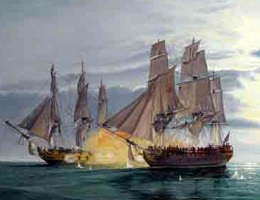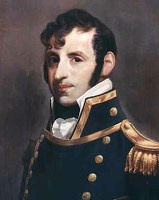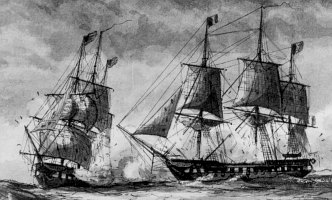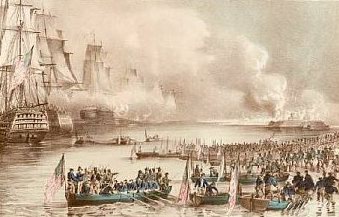The United States Navy
.
The Early United States Navy
.
American shipbuilding and oceanic shipping have
always been vital aspects of America from colonial times to the present
day. Protecting coasts and fisheries, protecting mercantile shipping
and fighting pirates marked early American naval efforts. For example,
the first colonial warship was built by Massachusetts colony to combat
piracy. Several hundred vessels and privateers were used for this purpose
before the United States became independent from England.
.
 Encounter off Flamborough Head
Encounter off Flamborough Head
- Bonhomme Richard and Serapis
-
|
.. |
During the American Revolutionary War, the
Continental Congress raised a small Navy of about fifty vessels, mostly
privateers, which performed various tasks and engaged in duels with enemy
ships. Such adventures provided a legacy of sea-fighting prowess. In 1776,
an American six-ship squadron struck the Bahamas Islands in the Atlantic.
The stirring encounter was between the British Serapis and the American
Bonhomme
Richard under Captain John Paul Jones became famed for his battle cry,
"I have not yet begun to fight!" |
.
When the United States was created after its
War of Independence, the nation sold off its warships. However, the country’s
Constitution of 1789 still provided for a potential Navy under the War
Department. Five years later, the US Congress made this capability a reality
in order to safeguard American commercial shipping from Mediterranean Sea
raids by Barbary pirate marauders.
.
| Six armed frigates were ordered to be built.
The 1797 completion of the frigate United States signaled the official
beginning of the new Navy.
The Barbary pirate menace was finally stopped
in 1815, after the Algerians surrendered to a dominant American naval squadron
commanded by Navy hero Stephen Decatur. |
..... |
 Captain Stephen Decatur, Jr.,
Captain Stephen Decatur, Jr.,
(1779-1820)
|
..
In 1798, as other frigates were almost ready,
America entered a period of oceanic hostilities against France. The US
fleet was centered on the frigates Constitution, United States
and Constellation, which were soon joined by nearly fifty other
smaller ships.
.

Capture of HMS L'Insurgente
by U.S. Frigate Constellation
in
1799
|
... |
Although the war was undeclared, there were
several clashes against French warships.
Congress recognized the need for a permanent
fighting force at sea, equipped with suitable supplies, and instituted
the Navy Department with an expanded fleet of available warships.
This war ended in 1799. |
.
The War of 1812, fought between the United
States and Britain, gave the Navy another test of battle on the high seas.
The Navy started the conflict with less than 20 warships.
The Navy Department could issue mission orders,
but the sailing tactics and distances of that time left actual battle decisions
up to individual ship captains.
Unfortunately, the large British Navy bottled
up most American ships and merchant ships in a close blockade that prevented
them from leaving harbor, although American privateers remained active.
| Nevertheless, a few daring frigates managed
to challenge British warships in open water, and fought valiantly in a
number of ship-to-ship actions which enhanced the reputation of American
sea power. For instance, the British ships Guerriere, Java,
and Macedonian were captured by Navy frigates.
Furthermore, the Navy won several victories
on inland lakes with its gunboat flotillas before the war ended. |
... |

Capture of H.B.M. Frigate Macedonian
by U.S. Frigate United States
in
1812
|
.

Captain Broke of the HMS Shannon
aboard the USS Chesapeake
in 1813
|
..... |
Nevertheless, the most famous Navy watchword
was uttered during the unfavorable duel between the British Shannon
and the American Chesapeake, when the latter was destroyed.
Its mortally wounded captain, James Lawrence,
famously commanded, "Don't give up the ship!" |
.
The Navy grew steadily in the next few decades,
but most naval activity was confined to peaceful patrols. Commencing in
1842, the Secretary of the Navy developed logistical and other bureaus,
refined technical shipbuilding advances, and administered the improvement
of crew performance and living conditions aboard ships. The Mexican War
of 1846 – 1848 gave the Navy an opportunity to impose a limited blockade
and conduct landing operations along both the Mexican Caribbean and Pacific
coasts.
.

Landing of the American Forces
under General Scott at Vera
Cruz." (1847)
..
.
[ I. Development ]..[
II. Facts about the WAVES ]..[
III. Uniforms ]..[
IV. Sources ]
|

